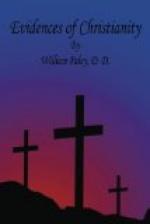VI. The same division, “Prophets, Gospels, and Apostles,” appears in Tertullian, the contemporary of Clement. The collection of the Gospels is likewise called by this writer the “Evangelic Instrument;” the whole volume the “New Testament;” and the two parts, the “Gospels and Apostles.” (Lardner, Cred. vol. ii. pp. 631,574 & 632.)
VII. From many writers also of the third century, and especially from Cyprian, who lived in the middle of it, it is collected that the Christian Scriptures were divided into two cedes or volumes, one called the “Gospels or Scriptures of the Lord,” the other the “Apostles, or Epistles of the Apostles” (Lardner, Cred. vol. iv. p. 846.)
VIII. Eusebius, as we have already seen, takes some pains to show that the Gospel of Saint John had been justly placed by the ancients, “the fourth in order, and after the other three.” (Lardner, Cred. vol. viii. p. 90.) These are the terms of his proposition: and the very introduction of such an argument proves incontestably, that the four Gospels had been collected into a volume, to the exclusion of every other: that their order in the volume had been adjusted with much consideration; and that this had been done by those who were called ancients in the time of Eusebius.
In the Diocletian persecution, in the year 303, the Scriptures were sought out and burnt:(Lardner, Cred. vol. vii. pp. 214 et seq.) many suffered death rather than deliver them up; and those who betrayed them to the persecutors were accounted as lapsed and apostate. On the other hand, Constantine, after his conversion, gave directions for multiplying copies of the Divine Oracles, and for magnificently adorning them at the expense of the imperial treasury. (Lardner, Cred. vol. vii. p. 432.) What the Christians of that age so richly embellished in their prosperity, and, which is more, so tenaciously preserved under persecution, was the very volume of the New Testament which we now read.
SECTION IV.
Our present Sacred Writings were soon distinguished by appropriate names and titles of respect.
Polycarp. “I trust that ye are well exercised in the Holy Scriptures;—as in these Scriptures it is said, Be ye angry and sin not, and let not the sun go down upon your wrath.” (Lardner, Cred. vol. i. p. 203.) This passage is extremely important; because it proves that, in the time of Polycarp, who had lived with the apostles, there were Christian writings distinguished by the name of “Holy Scriptures,” or Sacred Writings. Moreover, the text quoted by Polycarp is a text found in the collection at this day. What also the same Polycarp hath elsewhere quoted in the same manner, may be considered as proved to belong to the collection; and this comprehends Saint Matthew’s and, probably, Saint Luke’s Gospel, the Acts of the Apostles, ten epistles of Paul, the First Epistle of Peter, and the First of John. (Lardner, Cred. vol. i. p. 223.) In another place, Polycarp has these words: “Whoever perverts the Oracles of the Lord to his own lusts, and says there is neither resurrection nor judgment, he is the first born of Satan.” (Lardner, Cred. vol. i. p. 223.)—It does not appear what else Polycarp could mean by the “Oracles of the Lord,” but those same “Holy Scriptures,” or Sacred Writings, of which he had spoken before.




